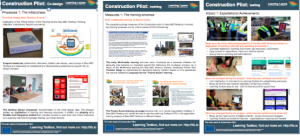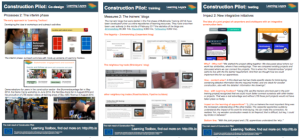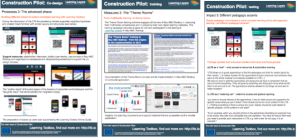Final Review of Learning Layers – Part Four: Questions, Challenges and Concluding Reflections
In my three previous posts I have been writing a series of posts on the concluding event of our EU-funded Learning Layers (LL) project – the Final Review. In the first post I explained how we came to the idea to organise the event primarily at the Norddeutsches Zentrum für Nachhaltiges Bauen ((NZNB) – North-German Centre for Ecological Construction Work in Verden, near Bremen). In the second post I focused on the contributions of the Construction Pilot – on our topics and how we presented our message (with poster wall, exploitation tables and presentation session). In the third post I focused on the comparisons between the Construction pilot and Healthcare pilot that I and Tamsin Treasure-Jones presented as tandem-presenters. In this fourth and concluding post I will discuss the overall picture of the meeting in the light of questions from the review panel, challenges posed for us regarding the finalisation of our work and further reflections to be presented in this context.
1) Questions on the contributions of the sectoral pilots and technical support activities
I start with the questions posed for Construction pilot team. As I see it, we were able to present a coherent story of participative co-design process, training activities and pilot testing that led to actual use of Learning Toolbox in the training of Bau-ABC Rostrup. Also, we could show that our partners in the ecological construction work are developing their own applications. The questions from the review panel were mostly posed to the practitioners – the Bau-ABC trainers Markus Pape and Stefan Wiedenstried. Markus and Stefan could inform of cases in which their trainers’ blogs and the Learning Toolbox were real support for the learning of apprentices. Concerning the conceptual interpretation of the pedagogic accents of trainers we had clarify a terminological confusion due to translation. (The metaphor ‘Learning toolbox as “well”‘ gave a different connotation as ‘source’ – two alternative translations for ‘Brunnen’.) Altogether, we could make the case that the use of pedagogy that promoted holistic view on the occupational tasks of the trade and empowerment of self-organised learners. Concerning the contribution of Bau-ABC and Netzwerk Nachhaltiges Bauen we got questions on the role of infrastructure, on the readiness of partner companies to work with internet and on the commitment to work with the tools. We could refer to several topics and to initiatives with which the organisations are already working.
Concerning the Healthcare pilot, the reviewers were keen to know more, what kinds of difficulties the pilot groups (with their respective tools) experienced, what kind of learning effects could be documented and how the integration of one of the tools (Living Documents) into widely used commercial software (Intradoc) is taking place. Also, the review panel was interested, how the transfer of Learning Toolbox from Construction pilot to healthcare education and to conferences is taking place.
Concerning the contributions of technical partners, the review panel was mainly interested to know. to what extent the overall infrastructure (WP 6) and the Social Semantic Server (WP5) were used by the pilots. Here, some examples could be mentioned that demonstrated that the tools were used in a common working environment. As regards the Learning Toolbox, Raymond Elfereink made the point that it was developed as a minimum viable product for active use. Therefore, the further steps of integration can be reached only at a later date.
2) Challenges for critical self-reflection on the process and results
On top of the specific questions on particular parts of the project the review panel had more overarching questions on the overall results of the project consortium. The way we had presented our results with an integrative website and supporting reports seemed to leave gaps of interpretation and unanswered questions. The reviewers wanted to get a deeper understanding on the reasons, what were the limits to our success (although the project made a serious effort) and what lessons should be learned for project work (on our side) and for terms of funding (at the level of funding policies). Here – without trying to give a complete answer – I would address the following points in the light of the Construction pilot:
a) Developing new software for, with and by the users: For the sake of argument some of the reviewers raised the question, whether it was realistic to introduce co-design and software development processes within the process? Could the project had worked on the basis of existing software solutions (by shaping IKEA-like package solutions)? Here all our experiences from the fieldwork speak for a user-oriented and user-engaging co-design process. Commitment to such process and the engagement of users was crucial to the success with Learning Toolbox. During different phases of the process there was sufficient user engagement to make sure that the toolset to became appropriate for the users.
b) Big software house or SME as the software development partner: Originally the Construction pilot was supposed to be supported by a big software house. However, after changes in the staff involved in the project, the software house was not willing to allocate developers that would engage themselves in the project. Instead they were insisting on using their ready-made products or getting specifications for piecemeal coding work (to be handed over to outsourced programmers). This was not compatible with the process dynamics with application partners. When the software house left the project, it was replaced by a an SME that was prepared to take a participative role in the co-design process. However, this change happened only after major administrative delays. Yet, only due to this change the Construction pilot got a flexible and integrative toolset that can be used in different contexts.
c) Was the time frame (in)sufficient for such of project or was the approach of the project (un)realistic for the time frame: To me these questions cannot be answered independently of the two above discussed points. As I see it, the given time frame would have enabled the Construction pilot team develop the Learning Toolbox to far more advanced stage. However, a considerable part of working time passed without effective technical support. And after the change the Construction pilot had go through a ‘catching up’ period. In the meantime other partners involved in the process had been developing their ideas and requests. Yet, in the remaining time the Learning Toolbox could at best be developed into a viable product only by the beginning of the last year.
3) Questions on transfer processes and scaling up innovations
During the Review meeting the reviewers posed questions concerning the processes of adaptation, transfer and ‘scaling up’ of innovations? We were challenged to reflect in a self-critical ways what we had achieved and what not. Also, we were challenged to work harder with the lessons learned. Here the reviewers were keen to understand, how the analysis of our experiences could help to develop future projects and funding criteria. Therefore, the issue was NOT, what we should have known better already in the beginning phase. To me the important push was to reflect on the factors that have had influence on the transfer processes and on the aim to scale up innovations. Here, from the perspective of Construction pilot I raise the following points:
a) Getting out of the primary pilot contexts: In Construction sector the primary pilot context was an intermediate training centre and its training projects at their premises and outdoor areas. In this context we reached clear results that demonstrated the usability of the Learning Toolbox and positive impact on the learning of apprentices. Yet, based on this experience (alone) we could not see much takeup in enterprises. On the contrary, the interested companies were looking for a more overarching approach to use Learning Toolbox to coordinate their work plans, logistics and mutual adjustment of different trades’ work processes (+ related informal learning). Such processes do not happen as ‘transfer’ of prior practices but need intensive customisation. At present there are several negotiations going on with companies who want to start their own mini-pilots with Learning Toolbox.
b) The role of multiplier-organisations in the ‘scaling up’ of innovations: In Construction sector the best known showcases for using Learning Toolbox refer to training activities in Bau-ABC and to coordination of a construction site in Verden. In both types ‘champions’ of application partner organisations play a central role. However, getting beyond such cases (and the company initiatives mentioned above) requires further motivational assets for the craft trade companies to get interested. In this respect the NNB (Network for ecological construction work) has drawn attention to the competition Grüne Hausnummer (and its marketing value). Likewise, Bau-ABC is in a good position to promote awareness of health and safety (Arbeitssicherheit und Gesundheitsschutz) at workplace and with user-friendly tools and web resources. Both these examples show that we are proceeding via narrower ‘exploitation corridors’ rather than stepping on broad avenues during our exploitation journeys – but as I see it, there are no alternative ways forward.
– – –
I think this is enough for the moment. We have got some homework from the reviewers and we want to complete our working and learning process in this project properly. As we see it, we were promoting genuinely innovative processes that developed tools worth using. And our application partners got their hands on the tools and confirmed that they were worth using. This gives us a basis to look forward.
More blogs to come …



